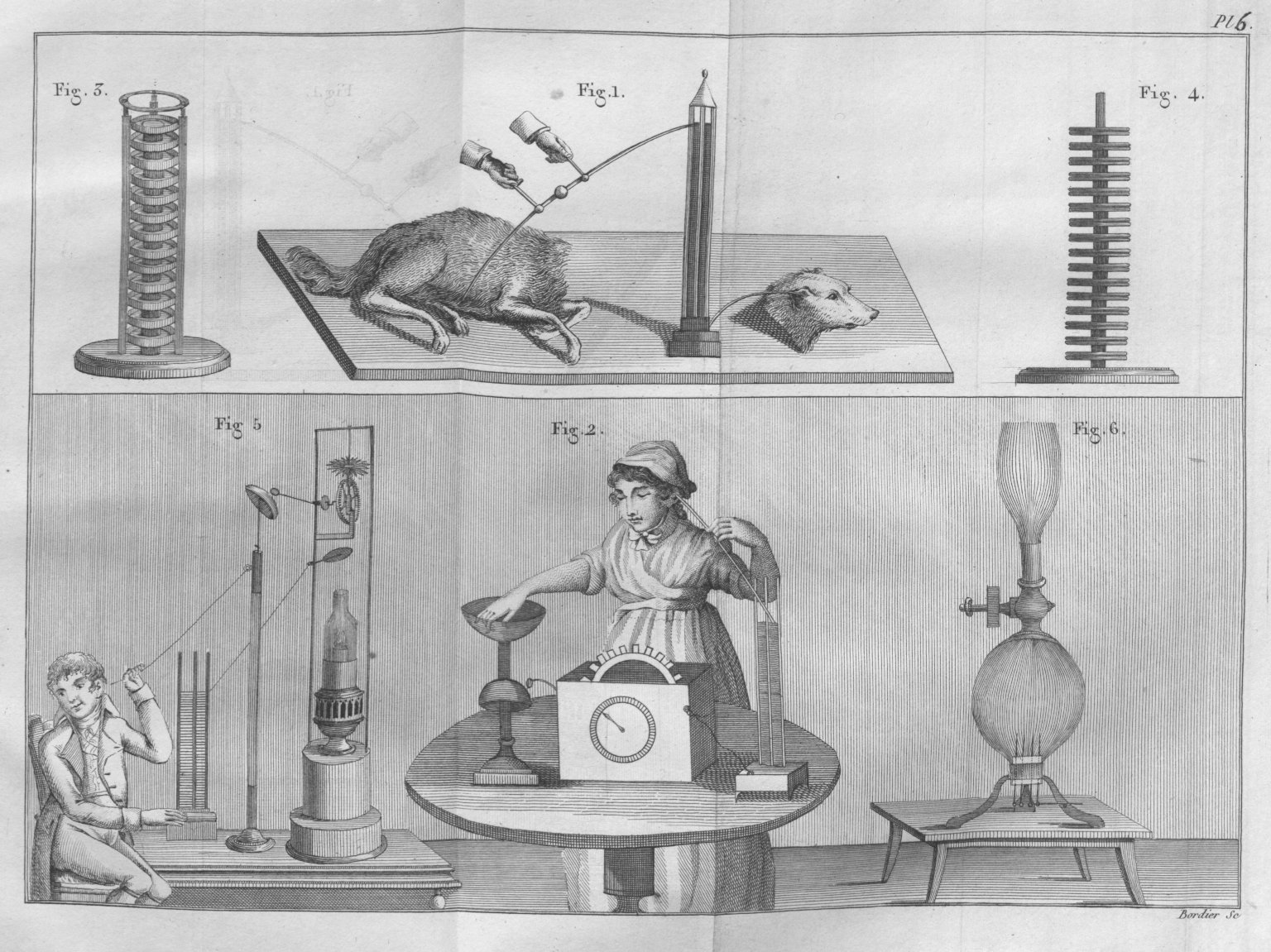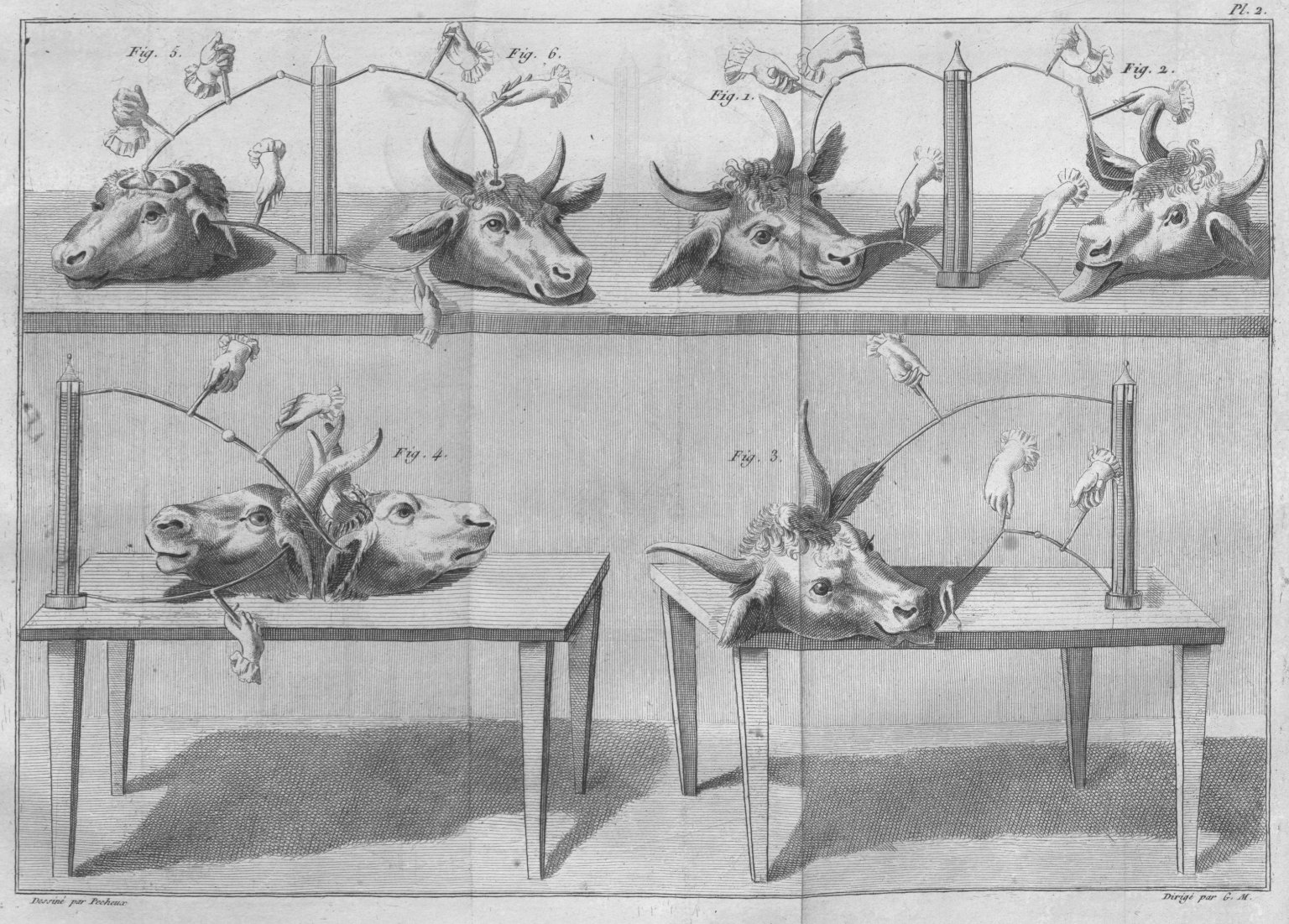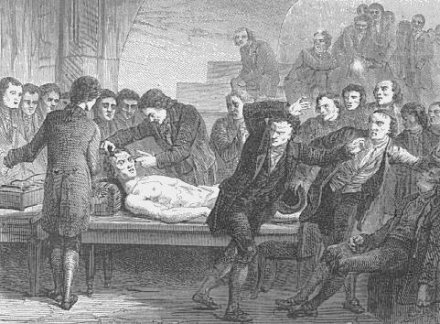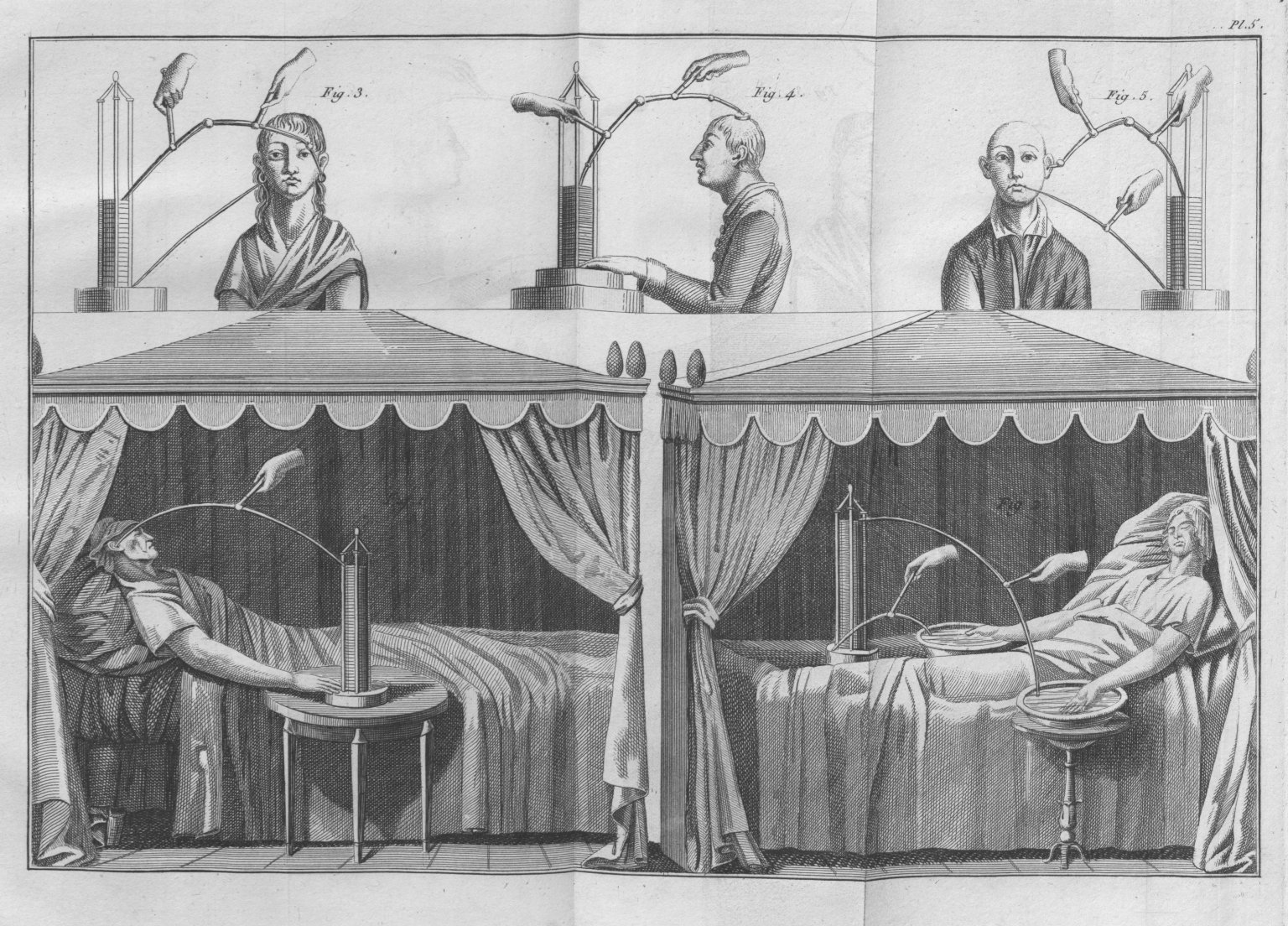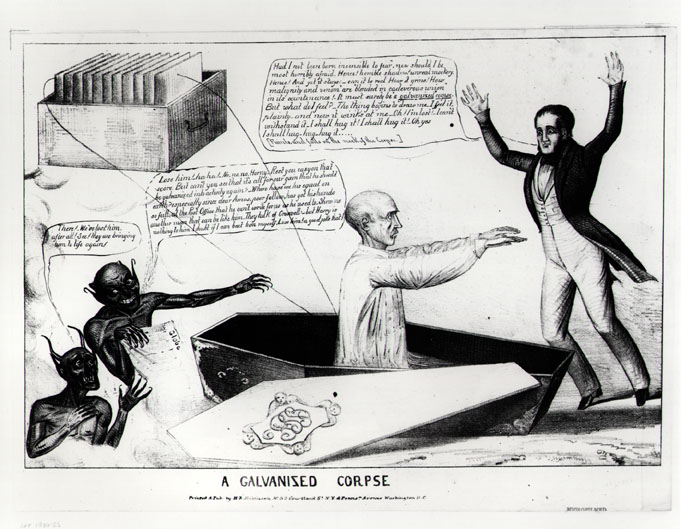“The jaw began to quiver, the adjoining muscles were horribly contorted, and the left eye actually opened,” recorded an attendee of a notorious 1803-demonstration of galvanic electricity’s powers of re-animation (qtd. in Mellor 105). The deceased, the recently hanged murderer George Forster, was made famous when the attempted reanimation of his corpse was widely reported in the British papers. This incident and its haunting description stand as a reminder of the scientific divide that existed among Romantic Britain’s leading scientists in their race to uncover the secret workings of the world around them and the world within the human body. The popularity and macabre interest in this new science seems to have sparked to life a dream that Mary Shelley reports resulted in the inspiration for Frankenstein. In the 1831 preface Shelley claims to have dreamt about a “hideous phantasm of a man stretched out, and then, on the working of some powerful engine, show signs of life, and stir with an uneasy, half-vital motion… [and opens his]… yellow, watery, but speculative eyes” (196). That very same “dull yellow eye” is one of the first things Victor Frankenstein sees after he infuses the “spark of being into the lifeless thing that lay at [his] feet” (38). The publicly displayed reanimation of Forster’s corpse was not a one-time spectacle. Public dissections and attempted galvanic-reanimations were common fare for nineteenth-century Western Europeans (Mellor 106). Fliers were handed out and all were welcome to attend these brutal displays, for there was a scientific debate raging between the materialists and the vitalists. To win the debate scientists such as John Aldini (the nephew of Luigi Galvani, of galvanism fame) sought to prove their merit publicly, rather than in clandestine laboratories.
Vitalists believed that there was “some form of animating power through-out nature” that distinguished inorganic matter, such as plants and rocks, from organic matter, such as animals (Holmes 314). Such scientific queries that sought to understand this animating power, or “life principle,” trod on what was traditionally theological and philosophical territory, for the search to define the life principle resulted in scientists attempting to quantify the soul (314). Building on Galvani’s theory of “animal electricity,” the prolific vitalist John Abernethy asserted that “the phenomena of electricity and of life correspond” (42). Thus, according to vitalist ideology, the life principle was not seated within the body, but outside it, and it was something that was transmuted into the body, imbuing it with life. On the other side of the scientific schism were the materialists, who did not believe that living organisms were fundamentally different from inanimate entities. The famous materialist William Lawrence—a good friend of the Shelleys—posited that the life principle did not originate from metaphysical phenomena or from vital spark-igniting electricity (Holmes 313). According to him life was generated from within human matter, for “living bodies, or in one word, life, has its origin in that of [its] parents” (qtd. in Butler xix). The idea that the life principle could be observed and understood was something that both the vitalists and the materialists believed was possible; the issue was whether that vital force was flesh-bound or not. Marilyn Butler, Anne Mellor, Richard Holmes and Denise Gigante among others have averred that Mary Shelley’s Frankenstein “allegorizes the Romantic obsession” with uncovering the origins of that animating principle (Gignate 160).
In her introduction to the Oxford edition of Frankenstein, Marilyn Butler argues that the novel is not a satire or a critique of vitalism or of materialism but “an impressionistic and composite group-portrait of the established science of the day as [Shelley’s] readers knew it” (xxxi). I agree with Butler that the novel is a burlesque depiction of Romantic science, but I do not think the tone of the novel is neutral. Frankenstein is one of the first cited works of science fiction (Malmgren 2). Mary Shelley extrapolates what the discovery and manipulation of the life principle might produce and explores the ramifications of man-initiated genesis. Theorist Darko Suvin has argued that science fiction does not comment on some distant tomorrow, but on the “author’s collective context” (Suvin 89). I propose that Mary Shelley is critiquing, rather than simply portraying, the scientific landscape of the early nineteenth century. I plan to explore how Romantic materialists attempted to understand and impose order on the natural world and how Frankenstein expresses anxieties related to their attempts to impose said order. Victor Frankenstein is often associated with the vitalist Abernethy because his obsession with the alchemists Cornelius Agrippa, Albertus Magnus, and Paracelsus implies that he his anti-materialist, but I will be looking at his similarities to the materialist George Cuvier, who dissected a Khoisan woman (Saarjite “Sarah” Baartman), and placed the pieces of her body, including her genitals, on display. At a time when scientists like Curvier and his ilk “sought to ‘order’ the natural world... [by] assigning to diverse plants, animals, and people a hierarchical position that supported the supremacy of European masculinity,” Baartman became representative of a link between human and animal (Hobson 20). I will be looking at the comparable similarities between Frankenstein’s creature and Baartman, whose biography tells a parallel, but reversed story of how materialists attempt to force deviant bodies to fit into taxonomical categories by deconstructing them into their constituent parts. Like the Creature, Baartman was seen was a monster due to fact that her body was deemed deviant; I believe that the novel illustrates how monstrosity is a construct that is not related to physical deviance, but to social up bringing.
The connection between Frankenstein and the search for the principle of life was made explicit in Shelley’s 1831 introduction. In Shelley’s recount of Frankenstein’s origins she cites a conversation between Lord Byron and Percy Shelley about the “nature of the principle of life, and whether there was any probability of its ever being discovered and communicated” (195). During that conversation Shelley and Byron spoke about the experiments of Erasmus Darwin, who had cut a polyp (a type of sea worm) into pieces and observed that those pieces all generated into new fully formed autonomous polyps.[1] According to Denise Gigante, “the morphological oddity of the polyp challenged the structural stability of the natural world and redirected naturalists back to the unsettling idea of formative power” (14). It is by contemplating “how the worm inherited the wonders of the eye and brain” that Victor discovers the “astonishing a secret” of reanimation (34). The syntax of this sentence is ambiguous enough to suggest that Victor may be alluding to Darwin’s polyp, for it is not clear whether he is implying that he was simply meditating on decomposition because his thoughts shifted “from life to death, and death to life,” for once cut into pieces the polyp should have died, but instead regenerated itself back into multiple lives (34).
Over a hundred years before The Origin of Species was published, Carl Linnaeus, the father of modern taxonomy, was already complicating the clear boundaries established by the Great Chain of Being. In Linnaeus’s Systems of Nature, published in 1735, he divided Homo sapiens into two separate species: Homo sapiens and Homo monstrous. The latter taxon was reserved for “wild and monstrous humans, unknown groups, and more or less abnormal people;” Homo monstrous was, in sum, reserved for humanoids who did not fit into the four races that Linnaeus outlined under the taxon Homo sapiens (Willoughby 33-34). Homo monstrous were exempt from the Homo sapien category because their “physical structures excluded them from being recognized scientifically as fully human” (Wilson 7). Thus, even if a person was born of human parents, that did not grant them exemption from being categorized as monstrous. A monster was not defined by its life principle or by its action, but by its physicality. While Caucasians, Asians and some African groups were categorized under the taxon Homo sapien, other races were excluded. Ambiguous figures, such as ‘Hottentots’ (as the Khoikhoi{C}[2]{C} then were called), were categorized under the taxon Homo monstrous because their bodies induced anxiety.
Frankenstein’s monster is born a creature of “gigantic stature,” built up from what Richard Holmes assumes are adult body parts (35). But in stark contrast to his fully developed form, the Creature’s mind is inchoate; it is “that of a totally undeveloped infant. He has no memory, no language, no conscience” (Holmes 331). Upon animation the Creature has no violent urges, nor any urges at all. He is not a prelocutionary being, for how can he understand the consequences of his actions if he hasn’t even the ability to even comprehend his environment: he “saw, felt, heard, and smelt at the same time; and it was, indeed, a long time before [he] learned to distinguish between the operations of [his] various senses,” (80). The Creature’s first introduction to civil society is to be chased by a mob of villagers, despite the fact that the Creature has done nothing malicious; according to his account he has “hardly placed [his] foot within the door before the children shrieked, and one of the women fainted” (83). The immediate reaction of the villagers is based solely on the Creature’s physical deviancy, a description of which the reader is only granted in bits and pieces. The Creature’s monstrousness is strictly visual up until he burns the De Lacey cottage. While living with the De Laceys the Creature learns about civil society through the family’s instruction of Safie. He acts as a shadow member of their community helping to keep them warm by bringing them wood and generally easing their labour. The Creature realizes that it is the “unnatural hideousness of [his] person [that] was the chief object of horror [to] those who had formerly beheld [him]” and attempts to ingratiate himself with the De Laceys through the blind De Lacey, for he recognizes that without sight De Lacey may accept rather than repel him (107). During their conversation De Lacey refers to the Creature as a “sincere…human,” but when the family sees the Creature they reject him violently (109). It is ultimately a culmination of rejections from civil society, a rejection that stems from the monster’s physical deviancy, which results in the Creature’s malignity.
Kant complicates the notion of monstrosity by defining it as something that is not a simple matter of physical deviance. For Kant an object is monstrous if the imagination cannot comprehend the object as a whole. In Critique of Judgement Kant writes that “[a]n object is monstrous if by its magnitude it nullifies the purpose that constitutes its concept” (109). Frankenstein’s Creature is both huge—he was a “being of gigantic stature, that is to say, about eight feet in height, and proportionably large”—and cannot be seen, at least from Victor’s perspective, as a whole being. Victor’s creation is also referred to repeatedly throughout the novel as a “monster.” The word monster is derived from the Latin monstrum, which in turn is derived from the verb monstro, to show (OED). Thus the root of the word monster is etymologically intertwined with the idea of spectacle. While the Monster retreated from public view, real Romantic “monsters” where put on display for the public.
Marilyn Butler illuminates a connection between the French naturalist Georges Cuvier and Victor Frankenstein, citing that the monicker Curvier coined for himself, ‘the magician of the charnel-house’ “would also do for Frankenstein” who spends his “days and nights in vaults and charnel-houses” panning for the perfect body parts (xxxi; 34). Three years before the publication of Frankenstein Cuvier became famous for dissecting the body of Saartjie “Sarah” Baartman, whose biography tells the inverse story of Frankenstein: she began as a whole that was broken down into her constituent parts. Baartman was a displaced Khoisan woman that was exhibited in Paris and London as a freak show attraction under the name “The Hottentot Venus” (“Hottentot” being the derogatory Dutch term for the Khoikhoi, and “Venus” emphasizing her supposed lasciviousness and her ironic irreconcilability with European ideas of feminine beauty). It was not Baartman’s blackness that made her monstrous, but her breasts and buttocks, which were too large according to European standards. Janell Hobson notes that under white surveillance “Baartman’s body [was] only recognized in fragmented parts (focusing almost exclusively on her buttocks) and viewed with pleasure when identified as freakish or exotic” (Hobson 39). Baartman’s sexual alterity was further accentuated after her death in 1815, when the Curvier dissected her and put her skeleton, brain and genitals on display at Paris’ Musée de l'Homme. Curvier was interested in Baartman because of her elongated labia minor (or “apron” as it was referred to by Curvier), was seen as quixotically phallic and irreconcilable with her hyper-feminized rear and breasts. It was Baartman’s paradoxical nature of being both hyper-feminine and ambiguously masculine that made her an object of fear, fascination, and a source of anxiety. Like Frankenstein’s creature she was a monster because she spilled out of a taxonimical and gender classifications due to the fact that her constituent parts were too large.
As Baartman is broken down into parts, Frankenstein’s monster is built up from a potpourri of pieces. In poetry, a blazon is usually used to catalogue a woman’s “admirable physical features”(OED), but when Victor sees his Creature come to life, his description of his “catastrophe” is an anti-blazon, illustrating the Creature’s ugliness, rather than its beauty:
His limbs were in proportion, and I had selected his features as beautiful. Beautiful! Great God! His yellow skin scarcely covered the work of muscles and arteries beneath; his hair was of a lustrous black, and flowing; his teeth of a pearly whiteness; but these luxuriances only formed a more horrid contrast with his watery eyes, that seemed almost of the same colour as the dun-white sockets in which they were set, his shrivelled complexion and straight black lips. (39)
What accounts for Victor’s sense that his creation is hideous? The emphasis on the Creature’s yellow skin and black lips seems to hint at an element of racism, but some of the monster’s constituent parts are described very complimentarily: the monster’s teeth are pearly, his hair is lustrous, and yet he disgusts his creator. Victor’s very language creates the effect that he is bemoaning: he cannot see the body as a whole; he can only see the monster in pieces. I posit that this is one of the factors that makes Victor’s creation a monster, not just in Kantian terms but also in taxonomical terms. The Creature is a mistake that cannot be classified by any category human society has to offer. And it is this liminality that is so horrifying for a nineteenth-century European. When Victor says, “I thought of the Creature nearly in the light of my own vampire,” he is articulating identity-related anxiety because if he embodies otherness and the other (the Creature) empathizes with him, then the boundary between self and other has dissolved (57). It is that very fluidity, this lack of fixity, which is monstrous and frightening to Victor. It is this anxiety regarding the instability of man-constructed boundaries between gender, race and bestiality that underlies the demonization of both Sarah Baartman and Frankenstein’s Creature. In sum, the Creature is a taxonomical deviant, but he is also monstrous from Victor’s perspective because his constituent parts do not coalesce to form a harmonious unity.
The form and content of the novel, however, are harmonious, for the novel is about a monster and is structurally monstrous. Bakhtin’s concept of heteroglossia would not be iterated for another century, but within Frankenstein there is a triple-nested narrative, a cacophony of voices, with a twice-mediated core. The form of the book is deviant and unclean compared to the much-venerated monologic Romantic poetry. There is no one omniscient narrator in Frankenstein. Instead, the reader only gets competing takes on events. If there is no authority then the novel cannot be organized into a hierarchy of truthfulness. The Creature’s perspective is presented as equally valid to Victor’s take on events. In this way Shelley privileges the Creature as a being of equal value when juxtaposed against the other two narrators, whose inhumanity and lack of sensibility only becomes more tangible as the novel progresses. Frankenstein’s monstrousness does not manifest in external body deviance, but through his malignant actions: both he and Walton are willing to give up more lives than the Creature ever took in their mission to chase the Creature through the Arctic Circle. The conclusion of the novel illustrates how monstrosity related to physical deviance can be productive and positive like the novel itself, whereas monstrosity that is derived from malignant actions is deconstructive and dangerous.
Question: Typically, science fiction is set in the future, but Shelley sets Frankenstein in the past. The dates given are 17--, which could mean the novel could be taking place as much as a century before Shelley penned it. Why do you think Shelley sets the novel in the past? And why does she obscure the exact date of the narrative?
Works Cited
Abernethy, John. An Enquiry into the Probability and Rationality of Mr. Hunter’s Theory of Life. London: Longman et al.1814.
Gigante, Denise. Life: Organic Form and Romanticism. New Haven: Yale University Press, 2009. Print.
Hobson, Janell. Venus in the Dark: Blackness and Beauty in Popular Culture. New York: Routledge, 2005. Print.
Holmes, Richard. The Age of Wonder: How the Romantic Generation Discovered the Beauty and Terror of Science. New York: Pantheon, 2008. Print.
Kant, Immanuel. Critique of Judgment. Ed. Werner S. Pluhar. Indianapolis, Ind: Hackett Pub. Co, 1987. Print
Malmgren, Carl Darryl. Worlds Apart: Narratology of Science Fiction. Bloomington: Indiana UP, 1991. Print.
Mellor, Anne Kostelanetz. Mary Shelley: Her Life, Her Fiction, Her Monsters. New York: Routledge, 1989. Print.
Shelley, Mary. Frankenstein, Or, the Modern Prometheus: The 1818 Text. Ed. Marilyn Butler. Oxford: Oxford University Press, 1998. Print.
Suvin, Darko. “Science Fiction and the Novum (1977)”. Defined by a Hollow: Essays on Utopia, Science Fiction and Political Epistemology. Ed. Peter Lang. Oxford (2010): 67-92. Print.
Willoughby, Pamela R. The Evolution of Modern Humans in Africa: A Comprehensive Guide. Lanham, MD: AltaMira Press, 2007. Print.
Wilson, Philip K. “Eighteenth-Century ‘Monsters’ and Nineteenth-Century ‘Freaks’: Reading the Maternally Marked Child.” Literature and Medicine. John Hopkins University Press (2002): 21.1. 1-25. Project Muse. Web. 20 Nov. 2012.
[1]{C} Percy Shelley’s 1818 preface also references Darwin: “The event on which this fiction is founded has been supposed, by Dr. Darwin, and some of the physiological writers of Germany, as not of impossible occurrence”, but the 1831 preface makes his discovery a more explicit generative factor that led to the novel’s creation (3).
[2]{C} An ethnic group from South Africa.
